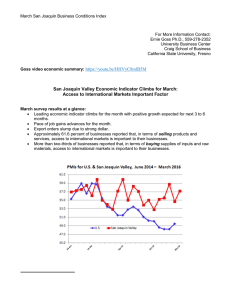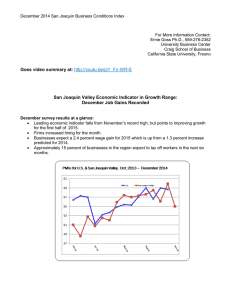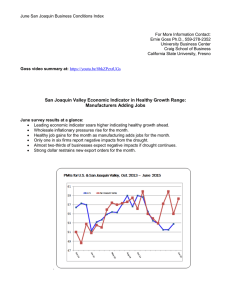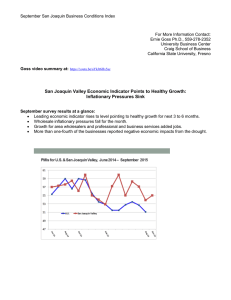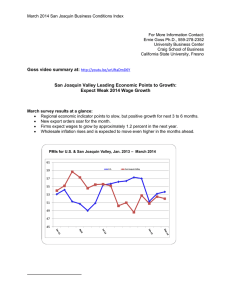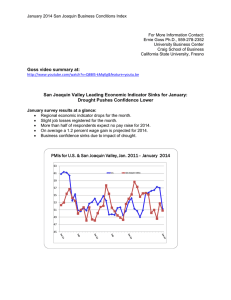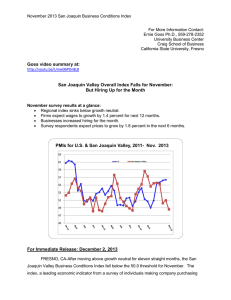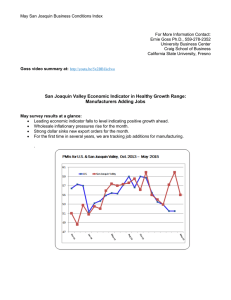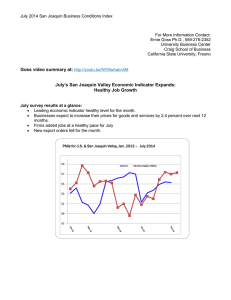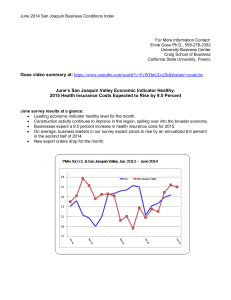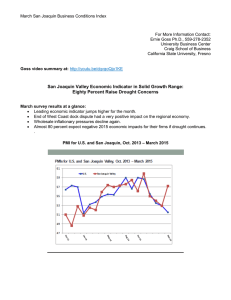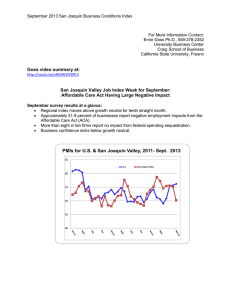Document 13092152
advertisement
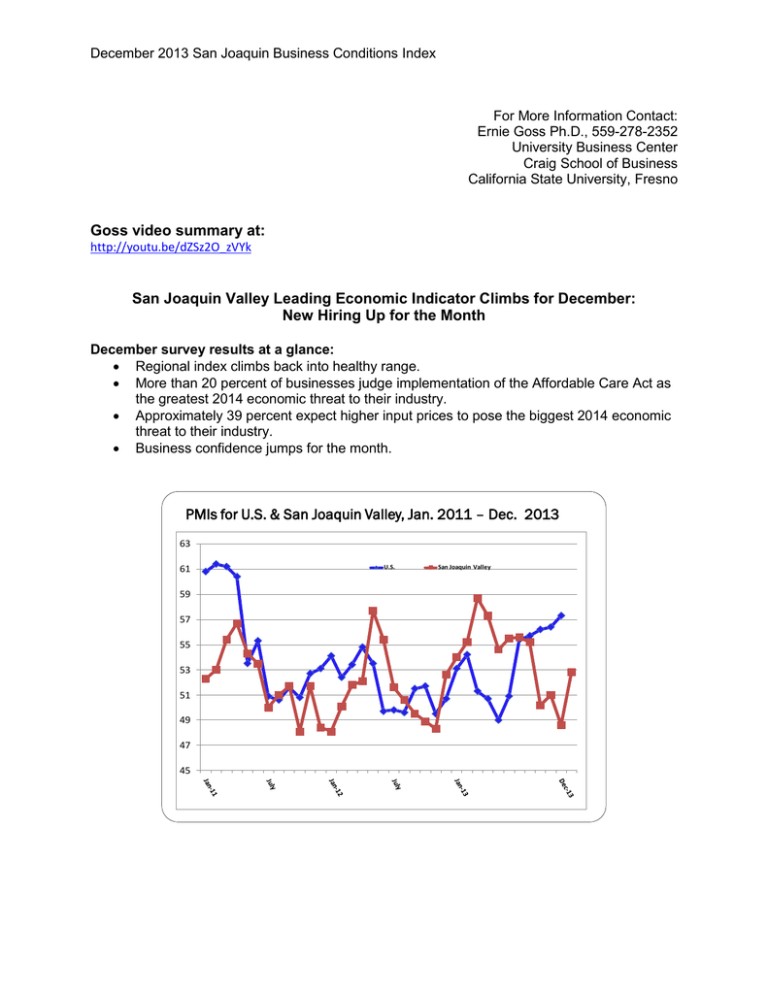
December 2013 San Joaquin Business Conditions Index For More Information Contact: Ernie Goss Ph.D., 559-278-2352 University Business Center Craig School of Business California State University, Fresno Goss video summary at: http://youtu.be/dZSz2O_zVYk San Joaquin Valley Leading Economic Indicator Climbs for December: New Hiring Up for the Month December survey results at a glance: Regional index climbs back into healthy range. More than 20 percent of businesses judge implementation of the Affordable Care Act as the greatest 2014 economic threat to their industry. Approximately 39 percent expect higher input prices to pose the biggest 2014 economic threat to their industry. Business confidence jumps for the month. PMIs for U.S. & San Joaquin Valley, Jan. 2011 – Dec. 2013 63 61 59 57 55 53 51 49 47 45 U.S. San Joaquin Valley San Joaquin Business Conditions Index – p. 2 of 4 For Immediate Release: January 2, 2014 FRESNO, CA-For the twelfth time in the past thirteen months, the San Joaquin Valley Business Conditions Index rose above the 50.0 threshold. The index, a leading economic indicator from a survey of individuals making company purchasing decisions for firms in the counties of Fresno, Madera, Kings and Tulare, points to positive growth for the next 3 to 6 months. The index is produced using the same methodology as that of the national Institute for Supply Management (www.ism.ws). Overall Index: The index expanded to 52.8 from 48.6 in November. An index greater than 50 indicates an expansionary economy over the course of the next three to six months. Survey results for the last two months and one year ago are listed in the accompanying table. “As a result of continuing economic uncertainty, companies in the area continue to expand output via temporary hiring. Firms in wholesale trade, food processing and business services are expanding economic activity. Construction activity continues to expand at a steady but slow pace,” said Ernie Goss, Ph.D., research faculty with the Craig School of Business at California State University, Fresno. This month businesses were asked to identify the biggest challenge to their company/industry for 2014. Approximately 39 percent named escalating prices for inputs purchased by their firm as the biggest threat. More than one in five, or 22.2 percent, indicated that higher costs and uncertainties surrounding implementation of the Affordable Care Act represented the top 2014 challenge for their business, while 16.7 percent identified declining customer demand as the number one 2014 potential risk for their business. No other issue rose above ten percent for survey participants. Employment: For 14 straight months, the hiring gauge moved above the growth neutral threshold. The job index climbed to 54.0 from 52.4 in November. Readings over the past several months indicate that the job market will continue to improve through the first quarter of 2014. “Expansions in construction, business services, and wholesale trade offset somewhat weaker manufacturing growth. However, as a result of economic uncertainty, companies continue to expand the hiring of temporary and contract employees. I expect permanent hiring to expand in the first quarter of the year,” reported Goss. San Joaquin Business Conditions Index – p. 3 of 4 Wholesale Prices: The prices-paid index, which tracks the cost of purchased raw materials and supplies, increased for the month. The wholesale inflation gauge climbed from 58.0 in November to 60.2 in December. "Inflationary pressures at the wholesale level remain fairly contained. However, approximately 39 percent of survey respondents expect higher prices for inputs of raw materials and supplies to be the greatest 2014 risk factor for their firm. While the Federal Reserve has announced that they intend to scale back their $85 billion bond buying program, termed QE3, by $10 billion in January, I expect the Fed to begin scaling this program more aggressively in the first half of 2014 as inflationary pressures at the wholesale level rise,” said Goss. Business Confidence: Looking ahead six months, economic optimism, captured by the business confidence index, soared to 54.2 from November’s 44.9. “The resolution of the federal budget impasse and improvements in the nation’s housing sector boosted the business outlook for the month,” said Goss. Inventories: Businesses once again reduced inventories of raw materials and supplies for the month. However, the inventory index expanded to a weak 46.1 from 40.0 in November. Trade: The new export order reading jumped to a healthy 57.0 from November’s weak 45.0. “Despite a stronger U.S. dollar making U.S. goods less competitively priced abroad, businesses in the area expanded export orders for the month. The regional import reading for December slipped to 50.6 from 51.2 in November,” said Goss. Other components: Other components of the December Business Conditions Index were new orders at 53.3, up from 44.2 in November; production or sales at 53.9 up from November’s 48.9; and delivery lead time at 56.7, down from 57.4 in November. Table 1 details survey results for December 2012, last month and December 2013. January survey results will be released on the first business day of next month, February 3. San Joaquin Business Conditions Index – p. 4 of 4 Table 1: Overall and component indices for last 2 months and one year ago (above 50.0 indicates expansion) San Joaquin Valley December 2012 November 2013 December 2013 Leading economic indicator 52.6 48.6 52.8 New orders 51.0 44.2 53.3 Production or sales 58.4 48.9 53.9 Employment 53.7 52.4 54.0 Inventories 46.1 40.0 46.1 Delivery lead time 53.8 57.4 56.7 Wholesale prices 59.1 58.0 60.2 Imports 41.9 51.2 50.6 Export orders 46.1 45.0 57.0 Business confidence 37.0 44.9 54.2 Craig School of Business: http://www.craig.csufresno.edu/ Follow Goss: Twitter at http://twitter.com/erniegoss or www.ernestgoss.com Blog: http://economictrends.blogspot.com
